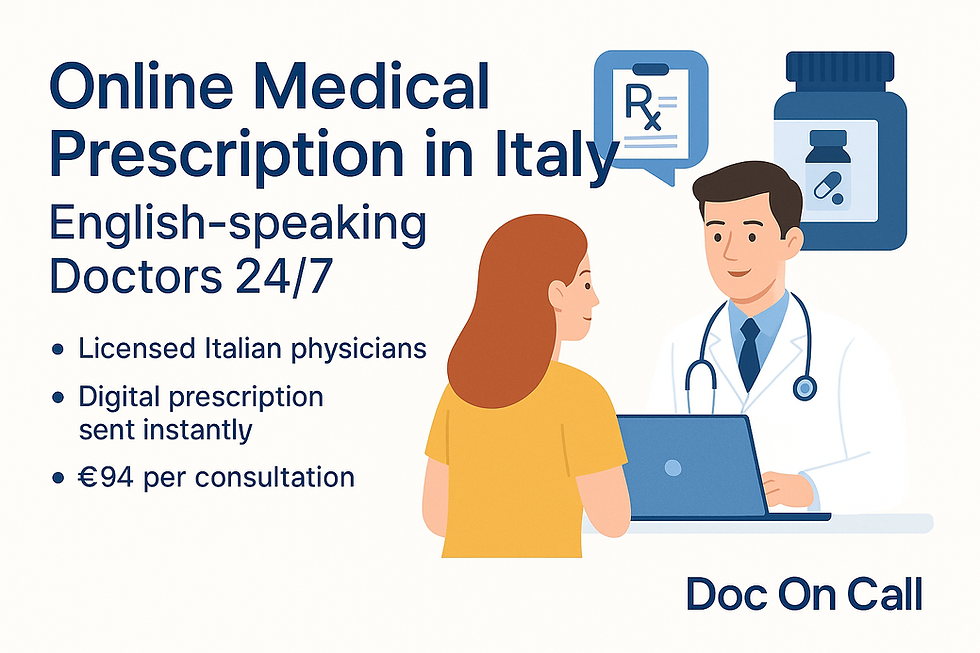Respiratory Tract Infections: Symptoms, Treatments, and the Support of Doc On Call Telemedicine
- Doc On Call
- Sep 21
- 2 min read
Updated: Oct 7
Why Respiratory Infections Increase in the Cold Season
With the arrival of autumn and winter, respiratory viruses (influenza, RSV, SARS-CoV-2, and rhinoviruses) find ideal conditions to spread. Enclosed spaces, poor ventilation, and weakened immune defenses facilitate transmission and contagion.The result? Every year, millions of people in Italy fall ill, with consequences on health, work, and quality of life.
How to Recognize the Symptoms of Respiratory Infections
Respiratory infections can affect the upper tract (cold, pharyngitis, laryngitis, sinusitis) or the lower tract (bronchitis, bronchiolitis, pneumonia). Symptoms vary in intensity, but the most common include:
Dry or productive cough (with mucus)
Fever and chills
Sore throat and difficulty swallowing
Nasal congestion, runny nose, postnasal drip
Muscle aches and fatigue
Headache and congestion
Shortness of breath (especially in lower tract infections)
Changes in mucus color (possible bacterial superinfection)
When to be concerned: if fever lasts more than 3–4 days, breathing difficulties, chest pain, or sudden worsening occur, it is essential to consult a doctor immediately.
Main Treatments: From Home Management to Targeted Therapy
Not all respiratory infections require specific medications. Often, symptomatic management is enough, but each case should be carefully evaluated.
Home Management
Adequate rest and proper hydration
Humidified, well-ventilated environment
Gargles, nasal rinses, steam inhalations
Symptomatic Medications
Antipyretics/analgesics (paracetamol, ibuprofen) for fever and pain
Nasal decongestants or saline sprays for congestion
Cough suppressants or mucolytics depending on the type of cough
Targeted Therapies
Antivirals (only in selected cases, e.g., confirmed influenza in high-risk patients)
Antibiotics only when bacterial infection is suspected or confirmed (bacterial bronchitis, pneumonia, complicated sinusitis). Inappropriate use promotes antibiotic resistance.
The Psychological Impact of Seasonal Illnesses
A respiratory infection is not only a physical disturbance: it also brings anxiety, concerns, and the difficulty of knowing when to seek medical help.Uncertainty amplifies symptom perception and may lead to extremes—either ignoring important warning signs or unnecessarily rushing to the emergency room.
Telemedicine: A Fast and Safe Answer
In this context, telemedicine is a modern, effective, and reassuring tool.With Doc On Call, you can access a qualified medical consultation without leaving home:
Rapid assessment of symptoms and possible causes
Clear guidance on home management
Prescriptions and personalized medical advice when needed
Immediate psychological support to reduce anxiety and uncertainty
Direction on when it is truly necessary to visit a hospital or your family doctor
Professionalism and Trust: The Added Value of Doc On Call
Every consultation on Doc On Call is provided by physicians registered with the medical board, following the latest clinical guidelines.The combination of scientific rigor and human attention makes telemedicine not just a practical solution, but also a valuable ally for both health and mental well-being.
Conclusion: Taking Care of Yourself, Always
Respiratory infections are inevitable during the cold season, but managing them with awareness and medical support reduces complications and stress.With Doc On Call, a doctor’s expertise is always just one click away—protecting your health without sacrificing peace of mind.






